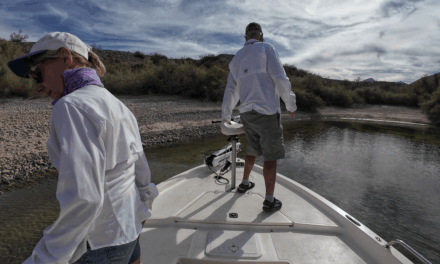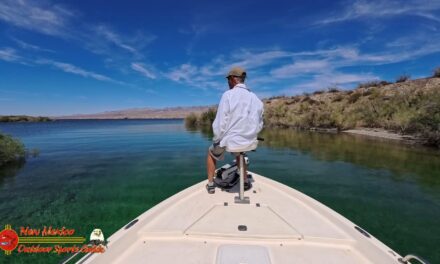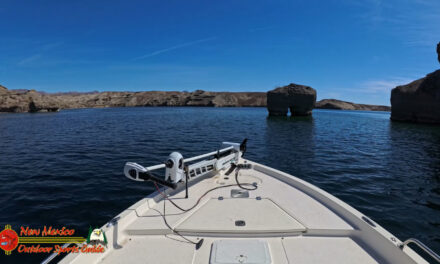Black Bass Magazine – Lake Mohave
As we reach the end of another year it’s time to reflect on our accomplishments and take a look at our goals for 1999.
Most of our members and sponsors are probably unaware of what a critical year 1998 was for Texas Black Bass Unlimited and our Black Bass magazine. One year ago this organization was deep in debt, over $90,000.00 to put a perspective on it.
As a result of some very hard work by our current board of directors I am proud to say that the organization is now out of debt and things are looking very positive for 1999.
The magazine has undergone some very big, and time-consuming changes during ’98. Most of these, although, transparent to most of our readers, were very significant indeed. We moved the layout of the magazine from Dallas, Texas to Nacogdoches, then to Willis, where it will stay for the foreseeable future. We also moved the layout from a Macintosh computer platform to PC, a very labor-intensive transition. The net result of all these changes was that our delivery of the publication on a timely basis suffered dramatically. With this issue, in fact, we remain one issue behind schedule. The January issue will be only one half issue behind and by March we will be back on schedule. Although these changes were costly in terms of magazine delivery they represent a dramatic improvement in the bottom line, long term, and to no small degree, account for the improvement in the organizations financial position.
As if we weren’t busy enough with all these changes many of our board members were busy helping to form a new organization you have been reading allot about in the past few isues, S.M.A.R.T.
In mid 1998 Texas bass fishermen, fed up with the impact habitat eradication was having on bass populations, united with clean water and clean air advocates to take a stand against this “War on Hydrilla.” Organizations like B.A.S.S. Federation, Texas, Black Bass Unlimited (TBBU), Texas Association of Bass Clubs (TABC), Honey Hole, Angler’s Choice, Bob Sealy Enterprises McDonald’s Big Bass, Pro Team Trails, Texas Oilman’s, F.I.S.H., B.A.I.T., H.A.W.K., Clean Water Action, The Chemical Connection, Lone Star Chapter of Sierra Club and many, many others put their heads together and formulated a plan. The plan is twofold, one of public education and to promote sound aquatic resource management, such as mechanical harvesters, rather than eradication. This coalition, now with over 300,000 combined members, has become well organized and formed a Non-Profit (501c) Corporation under the name of S.M.A.R.T. which stands for Sensible Management of Aquatic Resources Team.
One very important issue S.M.A.R.T. has been addressing with the Texas parks & Wildlife Department is the weed eradication issue on which S.M.A.R.T. has the following position:
Aquatic vegetation, as much a natural resource as our forests, is targeted for eradication. Bass fishermen say aquatic vegetation is habitat for game fish. Naturalists say aquatic vegetation is habitat to waterfowl. Biologists say that it is habitat for game fish and waterfowl. Environmental scientists say it is a natural filtration system for our lakes and rivers and that it is vital to clean water. So why would anyone want it eradicated….MONEY.
In keeping with our policy of defending conservation issues for bass anglers, Texas Black Bass Unlimited has taken the lead in forming this new organization to defend bass habitat in Texas. Your support will be greatly appreciated.
Results are already being recognized from the efforts of S.M.A.R.T. in that over $40,000.00 has been raised for the purchase of a Hydrilla Harvester to demonstrate the effectiveness of mechanical, rather than chemical, control of unwanted weeds and over $30,000.00 has been raised for the production of an education do*****entary video. This video will be distributed in our secondary and high schools around the country to educate youth and the general public on the benefits of aquatic vegetation to the environment and as game fish and waterfowl habitat.
Looking forward to 1999 your can expect to see, aside from a more timely delivery of this magazine, more informative conservation news stories, more insights from the pros on fishing and tournament strategies, more fishing reports and more sponsors with great new products for you to review. We also plan to offer more lake reports in upcoming issues. Anyone wishing to contribute please feel free to contact us.
Black Bass magazine and Texas Black Bass Unlimited has been and will continue to be the leader for conservation of our freshwater fisheries. Our many accomplishments, in that regard, speak for themselves. We have demonstrated and will continue
to demonstrate our concern for conservation by pro-active involvement with tough environmental and conservation issues in Texas and around the United States. As we have for years, we will continue to lead the way in freshwater fisheries conservation.
– Lake Mohave





